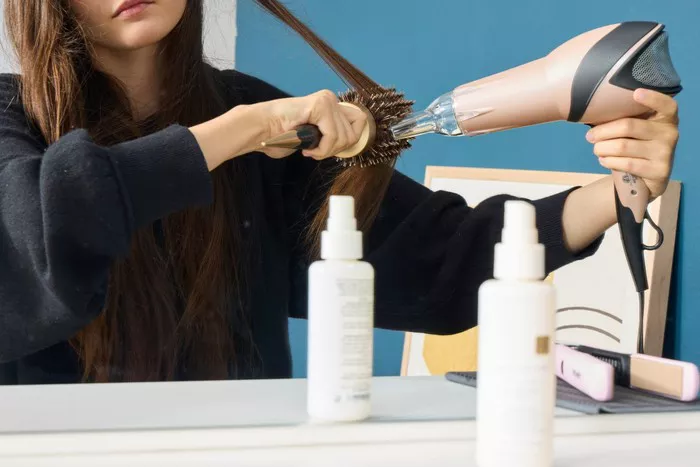Heat styling tools like flat irons, curling wands, and blow dryers are staples in many people’s beauty routines. They help create sleek, smooth, or voluminous hairstyles in minutes. However, these tools can also cause serious damage to your hair over time. This is where heat protectants come into play. If you’ve ever wondered what heat protectants are, how they work, or why they’re essential, this guide will break it down for you in simple, easy-to-understand terms.
What Is a Heat Protectant?
A heat protectant is a hair care product designed to shield your hair from the damaging effects of heat styling tools. It acts like a barrier between your hair and the high temperatures of your styling tools, reducing the risk of dryness, breakage, and split ends. Heat protectants come in various forms—sprays, creams, serums, and oils—and are applied to damp or dry hair before using hot tools.
Think of it like sunscreen for your hair: just as sunscreen protects your skin from UV rays, a heat protectant guards your hair from thermal damage. Most formulas contain ingredients that coat the hair shaft, lock in moisture, and reflect heat away from your strands.
Why Does Heat Damage Hair? Understanding the Science
To grasp why heat protectants matter, it helps to understand how heat affects your hair.
Hair Structure 101
Your hair is made of three layers:
- Cuticle: The outer layer of overlapping cells (like roof shingles) that protect the inner layers.
- Cortex: The middle layer containing proteins (keratin) and moisture, responsible for hair strength and elasticity.
- Medulla: The innermost layer, which is less relevant for most hair types.
When you apply heat, the cuticle lifts, exposing the cortex. High temperatures (above 300°F/150°C) break down the protein bonds in the cortex, weaken the hair shaft, and evaporate natural moisture.
Over time, this leads to:
- Dryness and frizz
- Split ends
- Brittle, broken strands
- Dullness and loss of shine
How Heat Tools Cause Damage
Flat irons and curling wads can reach temperatures up to 450°F (232°C). Blow dryers, while less intense, still expose hair to prolonged heat. Without protection, this heat literally cooks your hair, leading to irreversible damage.
How Do Heat Protectants Work?
Heat protectants create a protective shield on the hair’s surface.
Here’s how they function:
Form a Thermal Barrier
Ingredients like silicones (e.g., dimethicone) or polymers coat the hair, reflecting heat and preventing direct contact with the cuticle.
Lock in Moisture
Humectants (e.g., glycerin) and oils (e.g., argan oil) trap moisture in the cortex, preventing dehydration.
Smooth the Cuticle
Proteins (e.g., keratin) fill in gaps in the cuticle, creating a smoother surface that resists friction from styling tools.
Reduce Friction
Silicones and oils help styling tools glide through hair, minimizing tugging and breakage.
Types of Heat Protectants
Not all heat protectants are the same.
Choose one based on your hair type and styling habits:
Sprays
- Best for: Fine or thin hair.
- Pros: Lightweight, easy to distribute.
- Cons: May contain alcohol, which can dry hair if overused.
Creams
- Best for: Thick, curly, or coarse hair.
- Pros: Hydrating, adds definition.
- Cons: Can weigh down fine hair.
Serums
- Best for: Frizz-prone or damaged hair.
- Pros: Adds shine, tames flyaways.
- Cons: Use sparingly to avoid greasiness.
Oils
- Best for: Very dry or textured hair.
- Pros: Nourishing, doubles as a shine enhancer.
- Cons: Not all oils are heat-resistant; stick to argan or marula oil.
How to Use Heat Protectants Correctly
Using a heat protectant isn’t complicated, but doing it wrong can reduce its effectiveness.
Follow these steps:
Start with Clean, Damp Hair
Wash and condition your hair, then towel-dry gently. Most protectants work best on damp hair.
Apply Evenly
Section your hair and spray or massage the product from mid-lengths to ends (avoid roots to prevent greasiness).
Comb Through
Use a wide-tooth comb to distribute the product evenly.
Dry and Style
Blow-dry on medium heat, then use hot tools at a safe temperature (below 400°F for fine hair; up to 450°F for thick hair).
Pro Tip: Reapply a lightweight spray if you’re restyling the same section.
Benefits Beyond Heat Protection
Heat protectants do more than just guard against heat:
- Add Shine: Smooth cuticles reflect light better.
- Reduce Frizz: Sealed cuticles resist humidity.
- Moisturize: Ingredients like panthenol strengthen hair.
- Extend Color Vibrancy: Prevent fading caused by heat.
Choosing the Right Heat Protectant
Consider these factors:
- Hair Type: Fine hair needs lightweight sprays; curly hair benefits from creams.
- Ingredients: Avoid sulfates and drying alcohols. Look for keratin, argan oil, or UV filters.
- Styling Goals: Prioritize shine, hold, or hydration.
Myths vs. Facts
- Myth: “Heat protectants make hair bulletproof.”
Fact: They reduce damage but won’t eliminate it. Always use the lowest effective heat setting. - Myth: “You don’t need one if your tool has adjustable heat.”
Fact: Even low heat can cause cumulative damage.
3 Top Heat Protectant Recommendations
Budget Pick: Tresemmé Thermal Creations Heat Tamer Spray
Luxury Pick: Olaplex No. 9 Bond Protector Nourishing Hair Serum
For Curly Hair: SheaMoisture Coconut & Hibiscus Heat Protection Cream
Conclusion
Using a heat protectant is non-negotiable if you style your hair regularly. It’s a small step that preserves your hair’s health, shine, and strength over time. Pair it with occasional deep conditioning treatments and trim split ends regularly for best results. Remember: Healthy hair is always in style!
Related topics:
Can You Really Grow Thick Hair on a Bald Head?
6 Best Heat Protectants for 4C Hair: All You Need to Know
What Heat Protectants Do Salons Use? A Comprehensive Guide


